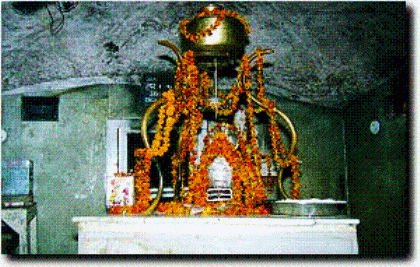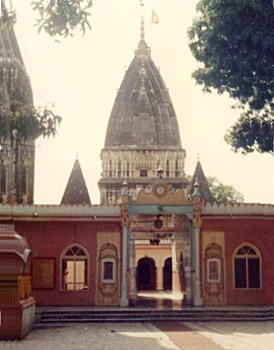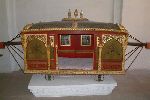How to reach here:
By Air: Jammu airport is well connected with many major airports in the country, including Delhi, Srinagar and Leh. Almost all air service providers operate regular flights from Jammu.
By Rail: The major railway station in Jammu is Jammu Tawi. Jammu Tawi is connected to all major cities in India including the southern most Trivandrum Railway station.
Best time to visit: October to April.
Languages spoken: Dogri, Hindi, Urdu and English.
Must eat: Chocolate Barfi, Sund panjeeri,Patisa, Kalaadi(processed cheese) and its exotic local food – Rajma (with rice) is one of the speciality dishes of Jammu.
Famous Restaurants: Falak Revolving, Yangtse, Imperial Grill, Moti Mahal.
Places you must visit:
Bahu Fort was built by Raja Bahulochan over 3,000 years ago. The fort was later restored during the 19th century by the Dogra rulers. Other notable attractions of the fort include Bahu Temple, a shrine dedicated to Goddess Kali.The fort stands on a plateau overlooking Tawi River with the surroundings developed into a well laid garden known as Bhave ki Bahu. Bhave ki Bahu is laid on the lines of the Mughal Gardens from where tourists can have a bird’s eye view of Jammu city.An ancient fort is placed within the thick sandstone walls and features eight octagonal towers with enclosures to house guards. There were several reconstructions from time to time in the fort; the last was done by Maharaja Gulab Singh in the 19th century.

Nandini Wildlife Sanctuary houses various species of pheasants. The reserve was established in an area of thick forests along with wildlife and is situated 28 km from Jammu.A popular dwelling of pheasants, the sanctuary is home for avifauna species that include Indian mynah, red junglefowl, cheer pheasant, blue rock pigeon, Indian peafowl and chakor.The wildlife sanctuary is spread over an area of 34 sq km, providing refuge to various fauna. Leopard, wild boar, Rhesus monkey, bharal and grey langur are some of the species of the reserve.

Sanasar is located at an altitude of 2,079 metres above sea level provides a peaceful environment. The site is also known as mini Gulmarg and is surrounded by huge conifers.It is built in a cup-shaped meadow and is one of the secluded regions of the country. Owing to the confluence of hilly terrain and plains, the site is ideal for paragliding, trekking and skiing, horse riding, hot air ballooning and camping. The Nag Temple, Hidden Creek and Waterfalls in the surroundings can also be visited.

Raghunath Mandir, dedicated to Lord Rama, was commissioned by Maharaja Gulab Singh, founder of the Kingdom of Jammu and Kashmir in 1835. The construction of the temple was completed by his son Maharaja Ranbir Singh in 1860.The inner walls of the holy sanctum are covered with gold sheet on all the three sides. There are several galleries in the shrine dedicated to various gods and goddesses associated with the Ramayana. Along with Raghunath Temple, there are 17 other shrines nearby including the Panjbakhtar Temple and Ranbireshwar Temple.There are several statues of deities and shivalingas along with religious inscriptions. Besides Hindu gods and deities, a figurine of King Ranbir Singh is also placed at the entrance. There is a Sanskrit Library, which has a rich reserve of the rarest collections of manuscripts and ancient books.

Amar Mahal Museum served as the family residence of the Dogra Dynasty. The palace was built by King Raja Amar of the Dogra Dynasty during 1890 using red sand stone.Planned and designed by a French architect, the architectural marvel was converted into a museum exhibiting a rich collection of paintings, books, inscriptions and artifacts.The structure of the building is identical to European castles, as there are sloping roofs with turrets and tall towers. There are extended passages on three sides of the monument, covered by sloping corrugated tin roofs.Along with wooden framework, the highlight of the first storey of the palace building is the French windows. These windows illustrate classical Greek architectural style in triangular projections fitted over ornate false columns.Durbar Hall of the art gallery displays family portraits of the rulers of Jammu and Kashmir along with a collection of Pahari paintings. The main highlight of the museum is the throne of Maharaja Hari Singh made of 120 kg gold.The museum houses over twenty five thousand books on history, among which the volumes associated with Raja Amar Singh are noteworthy.

Ranbireshwar Temple was constructed in 1883 by Maharaja Ranbir Singh. The temple dedicated to Lord Shiva comprises two halls decorated with the images of Ganesha and Kartikeya. There are several shivalingas in the shrine along with a Nandi Bull.The temple houses a central shivalinga measuring 7.5 feet in height along with twelve small crystal shivalingas measuring 15 cm.

Dargah Garib Shah is an ancient shrine dedicated to the spiritual leader Garib Shah, who preached doctrines of humanity to his disciplines. Dargah Garib Shah draws devotees from different religious backgrounds round the year.According to belief, homage at the sanctum fills life with happiness.
Bahu Temple is one of the ancient temples of Jammu, which is situated on a rock face on the left bank of River Tawi. The foundation stone of the temple within Bahu Fort complex is believed to have been laid over 3,000 years ago by Raja Bahulochan. The holy shrine dedicated to Goddess Kali is popularly known as Bawey Wali Mata.The sanctum was set up in 1822 during the reign of Maharaja Gulab Singh. As per the folklore, Goddess Bawey Wali has mystical powers identical to Mata Vaishno Devi.

Bagh-e-Bahu is a beautiful garden laid identical to Mughal Garden and is situated on the embankment of Tawi River.The garden is surrounded by acres of woods, which give a beautiful view of the city.

Mubarak Mandi Complex is among the chief sites of historic significance, which was also the royal residence of Dogra rulers during the days of yore. The 150 years old complex features 76 government offices and courts.At the complex, palaces are built as a group of buildings around the courtyard. Successive Dogra rulers extended the complex and used the building as the residences of the royal Dogra families. At present, there are halls and galleries in the complex that are used for official and public events along with housing government offices and courts.The oldest testimony of the complex dates back to 1824. The architecture and artwork belonging to Mughal and Rajasthani style along with 17th century European style attract tourists from around the world. Some of the chief attractions of the complex are the Sheesh Mahal, Royal Secretariat and Dogra Art Gallery, the erstwhile Pink Hall.



Dogra Art Museum is a famous art repository situated in the Mubarak Mandi Complex. This historic gallery is presently located in the Pink Hall, which houses over 800 rare paintings and articles of historical significance. There are separate galleries, where paintings from Basholi, Jammu and Kangra schools have been displayed.The major attraction of the museum is the gold painted bow and arrow of Mughal Emperor Shah Jahan along with carpentry tools. Besides, there are several handwritten manuscripts of Shahnama and Sikandernama in Persian that draw attention of history lovers.

Bagh-e-Bahu Aquarium has 24 aquarium caves, which include 13 small caves housing freshwater fish.Apart from these small caves, large caves have marine water fish, whereas nine medium sized aquariums contain fresh water fish. The aquarium features over 400 varieties of freshwater and marine fish.At the site, there is a public gallery, museum, laboratory and multimedia centre for aquatic awareness. The entrance and exit of the aquatic gallery is designed in the shape of the mouth of a fish.

Shiv Khori is one of the important cave shrines of Jammu, which is famous for the natural formation of a shivalinga. The 150 metres long shrine is among the most respected cave shrines of Lord Shiva in Jammu.The major highlight of the shrine is the 4 feet svayambhu lingam. The revered figurine constantly baths in a milky lime fluid dripping from the ceiling. There are several natural impressions and images of Hindu deities on the cave walls.
Mansar Lake is surrounded by forest covered hills. On the eastern bank of Mansar Lake, there is the Sheshnag Temple housing a figure of a snake with six heads. The water body is associated with a mythological legend.Along with recreational facilities, the rich flora and fauna draws the attention of tourists. There is a cemented path around the water body along with decks for sighting birds, turtles and fish.The wildlife sanctuary at the site provides shelter to spotted deer and neelgai along with water birds such as cranes and ducks. Umapati Mahadev, Narsimha and Durga Temple are some of the notable religious shrines in proximity of Mansar Lake.

Surinsar Lake is a beautiful lake situated in the midst of thick forests with hilly terrains in the backdrop.The lotus flower blossoms are the major attractions of the water body. As per myths, legendary warrior Arjuna, of Mahabharata, shot an arrow to the Mansar land, which pierced the earth at a site known as Surinsar.

Peer Kho Cave Temple is one of the sacred cave temples in the region, which is dedicated to Lord Shiva. The cave temple, also known as Jamwant Cave, is enshrined with the svayambhu shivalinga.The temple is placed in the acacia forest along igneous rocks and is believed to be one of the most ancient religious sites in the region.

The Akhnoor Fort is one of the famous historic testimonies belonging to the early 19th century. The testament in the ancient town of Akhnoor is situated along with the River Chenab at a distance of 32 km from Jammu.The ancient fort was built on the site belonging to the Harappan Civilisation. Along the fort, there is a two-storeyed palace which has decorated arches and murals.
The Gadhadharji Temple is one of the revered shrines constructed during the reigns of Maharaja Gulab Singh. Located along Mubarak Mandi Palace, the temple houses two life-size statues of God Narayana and Goddess Lakshmi. Apart from religious significance, the monument is appreciated for architectural artistry.

The Mahamaya Temple is dedicated to a regional female protagonist. As per historians, Mahamaya fought bravely against foreign invaders and achieved martyrdom around 14 centuries ago. This temple in situated on the banks of River Tawi opposite to the Bahu Fort.

Rani Charak Mahal is one of the famous historic testimonies, located on the banks of the River Tawi. A part of the Mubarak Mandi Complex, the ancient monument houses several government offices in its premises. Built of red stone, the mahal was constructed over 150 years ago.The monument is connected with treasury house, also known as Toshakhana of the Mubarak Mandi Palace. Arches and columns illustrate the architectural style predominant during that era. There are several valuables housed in the palace, which include artefacts like antique idols, a golden throne, palanquins and utensils.

Aap Sambhu Temple Sathrian is one of the famous religious centres of Jammu located in Sathrian of Roopnagar. The site represents the traditional legacy of the territory, which features a natural shivalinga.

Visiting Jammu and not going to Vaishnodevi temple is not an option. Lets move on towards the holy temple.
MATA NE BULAYA HAI!!
No comments:
Post a Comment